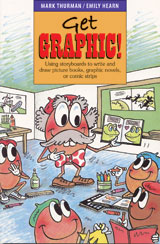Learn with Storyboards
Get Graphic! Using Storyboards to Write and Draw Picture Books, Graphic Novels, or Comic Strips
by Mark Thurman and Emily Hearn
Pembroke, 2010 – Learn more
As a person who works with upper elementary students to both organize their written work and to use photography and video to create stories, I was eager to see this book, and I was not disappointed.
As most teachers and parents know, getting a child to sit down and plan before starting a project is usually more difficult than getting the project completed. This book, with its entertaining style and engaging graphics, can lead a student through the planning process easily and thoroughly. Each chapter opens with a short guide for adults, and then talks directly to the students.

A great deal of time in spent on drawing—the part most kids want to do. And this book with its many clear explanatory drawings makes that part seem simple, which is great for our reluctant artists. Thurman and Hearn make drawing scenes from different points of view look easy, or at least easier, to this non-artist. I particularly like the manner in which they give the theory behind the different points of view for drawings. For example, close-up-views are the most emotional part of the story. They also help us understand how to portray action and perspective.
Slow Down and Organize
As they guide the student through the creation process, the authors emphasize organization and creating drafts, traits we all want to see in our kids. They provide storyboard examples and templates that made me want to get out some markers and start something—very tempting! In my experience, storyboarding is one of the hardest things for elementary students to do—they want to rush to the end and see the finished product, and they are invariably disappointed. This book can go a long way toward stemming those impulses as it encourages and rewards carefully planning and execution while keeping interest high.
Other chapters in the book include detailed instructions on how to assemble books, making and using collage illustrations, using collages of letters and finding and using patterned papers, styles of lettering and making covers. I also appreciated the vocabulary pages titled “The Way an Artist Speaks”—we always need this but seldom find it in books for both teachers and students.
Writing the story comes last, as it should in a well-planned student effort. By the time you and your students have worked your way to this point, writing is almost effortless—all the planning and preparation is done.
As a technology specialist and elementary teacher, I would highly recommend Get Graphic! for all K-12 students—in content areas, art, and in supplemental programs using technology to create visual products.
And most of all, who could resist a book that has as its very first chapter title “Read, Read, Read!”
Laura Reasoner Jones is a National Board Certified Teacher in early childhood education and also holds a master’s degree in library media. She is a technology specialist in a northern Virginia public elementary school and also supports STEM careers clubs for girls.































